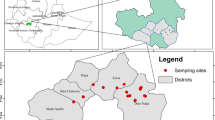Abstract
The study describes the capacity of trees to control the rise in water table and thus prevent the formation of waterlogged soils and development of secondary salinization in canal irrigated areas. It was conducted in RCC lysimeters of 1.2 m dia. and 2.5 m depth filled with sandy loam alluvial soil (Typic Ustochrept), with provisions to maintain water table depth at 1, 1.5 and 2 m from the surface and groundwater salinity at 0.4, 3, 6, 9 and 12 dS m-1. The amount of water biodrained by eucalyptus (Eucalyptus tereticornis) and bamboo (Bambusa arundinacea) at the given water table depths and groundwater salinity levels was monitored over four years by daily measuring the water needed for maintaining the water table. The trees continued to absorb and transpire water throughout the year, the capacity being more in summer and rainy than that was in the winter season. The eucalyptus plant could biodrain 2880, 5499, 5518 and 5148 mm of water in the first, second, third and fourth year of study period, from non-saline groundwater and a water table depth of 1.5 m. The amount of water biodrained was more at 1.5 m as compared to 1 and 2 m water table depths. The biodrainage capacity of trees was significantly affected by the salinity of the groundwater. However, even at salinity of 12 dS m-1, the eucalyptus plant biodrained 53% of that under non-saline conditions. It was calculated that biodrainage could control water table rises upto 1.95, 3.48, 3.76 and 3.64 m in first, second, third and fourth year, respectively. The secondary salinity developed in the root zone, upto 45 cm depth, did not exceed 4 dS m-1 even at water table depth of 1 m with salinity of 12 dS m-1. The volume of water biodrained by bamboo increased with time and could control water table rises upto 1.09, 1.86, 2.46 and 2.96 m in first, second, third and fourth year of growth, respectively.
This study indicates that due to high transpiration capacity and an ability to extract water from deeper layers containing saline groundwater, the trees can control the rise in water table in irrigation command areas and prevent the formation of waterlogged and eventually the saline wastelands.
Similar content being viewed by others
References
Alvares C. 1982. Social forestry – the likely distortions. Bio. Energy Res. News 1(1): 1–6.
Anonymous. 1991. Report on problem identification in irrigated areas with suggested remedial measures. Ministry of Water Resources, Government of India, New Delhi.
Babla A.M. & Soliman M.F. 1978. Evaluation of the relative specific effect of cations on plant growth and nutrient absorptions. 11th Intern. Soil Sci. Congr. Edmonton 1: 319–320.
Calder I.R. 1986. Water use of eucalyptus – a review with special reference to South India. Agric. Water Management 11: 333–342.
Chhabra R. 1987. Forestry−a cure for sewage pollution. Aquaworld 11(6): 185–187.
Chhabra R. 1988. Conservation of nutrients and irrigation potential of domestic waste waters sans pollution. J. Soil Water Conser, India 32: 113–123.
Chhabra R. 1990. Preventing sewage pollution of water bodies through afforestation. J. of the Institute of Public Health Engineers, India 2: 1–14.
Chhabra R. 1991. Sewage water utilization through forestry. Brochure No. 15. Central Soil Salinity Research Institute, Karnal, India.
Chhabra R. & Baddesha H.S. 1985. Sewage water for afforestation. Proc. National Seminar on Man, Forest and Environment, Haryana Forest Department, Karnal, India.
Greenwood E.A.N. & Beresford J.D. 1979. Evaporation from vegetation in landscape developing secondary salinity using the ventilator chamber technique (1) Comparative transpiration from juvenile eucalyptus above saline ground water seeps. J. Hydrology 42: 369–382.
Greenwood E.A.N., Klein L., Beresford J.D. & Watson G.D. 1985. Differences in annual evaporation between grazed pasture and eucalyptus species in plantations on a saline farm catchment. J. Hydrology 78: 261–278.
Hanada A.M. & El−Enany A.E. 1994. Effect of NaCl salinity on growth and mineral element contents and gas exchange of plants. Biologia Plantarum 36(1): 75–81.
Heinrich P.A. & Sands R. 1990. Water use by trees. Woodlots Workshop, Proceeding No. 32, Victoria, Australia. pp 47–52.
Panse V.G. & Sukhatme P.V. 1967. Statistical Methods for Agricultural Workers. ICAR, New Delhi.
Rawat P.S., Gupta B.S. & Rawat J.S. 1984. Transpiration asaffected by soil moisture in eucalyptus. Indian Forester 110(1): 35–39.
Rawat P.S., Negi D.S., Rawat J.S. & Gurumurti K. 1985. Transpiration, stomatal behavior and growth of Eucalyptus hybrid under different soil moisture levels. Indian Forester 111: 1097–1111.
Roberts J. 1983. Forest transpiration: A conservative hydrological process. J. Hydrology 66: 131–141.
Sharma M.L. 1984. Evaporation from a eucalyptus community. Agric. Water Management 8: 41–56.
Sumayao C.R., Kenemasu G.T. & Hodges T. 1977. Soil moisture effects on transpiration and net CO2 exchange of sorghum. Agric. Meteorology 18: 401–408.
Tanji K.K. & Karajeh F.F. 1993. Saline drain water reuse in agroforestry system. J. Irrigation and Drainage Engineering 119(1): 170–180.
U.S. Bureau of Reclamation. 1984. Drainage Manual. U.S. Department of the Interior, Bureau of Reclamation, Denver, Colorado, 2nd edition. pp 286.
Author information
Authors and Affiliations
Rights and permissions
About this article
Cite this article
Chhabra, R., Thakur, N. Lysimeter study on the use of biodrainage to control waterlogging and secondary salinization in (canal) irrigated arid/semi-arid environment. Irrigation and Drainage Systems 12, 265–288 (1998). https://doi.org/10.1023/A:1006104428674
Issue Date:
DOI: https://doi.org/10.1023/A:1006104428674




